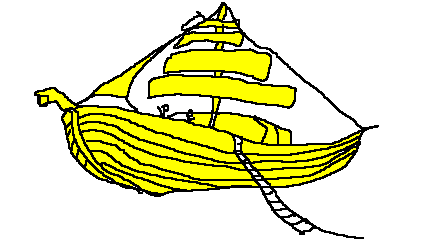

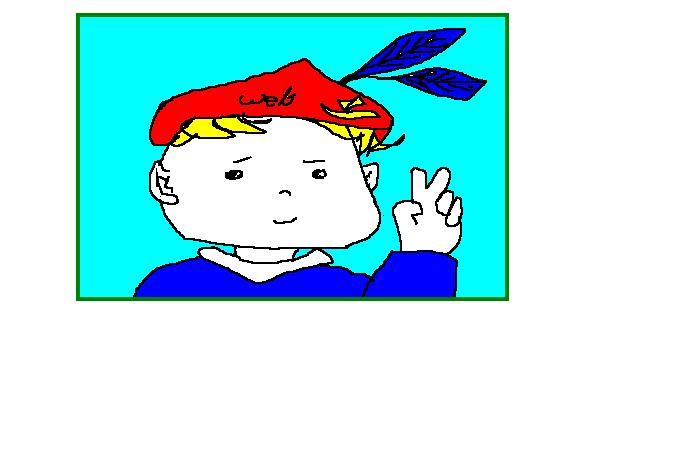 ちょっと、ウェブの顔を描くから、じっとしてろよ
ちょっと、ウェブの顔を描くから、じっとしてろよ
「おじゃましまーす、ルミコです」
「どーもどーも、あっしは、わかってるね?」
「いや、大勢で押しかけて、もうしわけないがな、ウホン」
[コンチワーデス、ネッツィー、デス]
[ぼく、ゴーファーです]
[わたし、ユードラともうします]
<あれー、おねえちゃんはー?>
「いるよ、いるよ、ほら、あそこに、エム、はずかしがらねえで、こっち、きなって」
「ゥン、...です」
「ま、そういうわけで、こんなところだな」
やあ、はじめまして、ということもないな
「それで、なにかね、記念写真でもとるのかい?」
いや、ちょっとポートレートでも描こうかと思ってね
「なるほど、これ、ウェブのやろうだな、ま、実物よりよくできてらあな」
<なかなかいいよー>
「結構結構」
[とてもよく描けてるとおもいます]
「そうね」
えーと、次はだれにしようかな
「シャラクネ、あんた、描いてもらいなよ」
「てやんでえ、ちーっと、はずかしいじゃねえか」
「だいじょうぶ、だいじょうぶ、どう飾ったって、元が元だからね」
「なにを、このやろう」
「まあまあ、内輪もめはしなさんな」
「ほらほら、ちゃんとボタンをはめて」
「しょうがねえなあ、ま、いいや、いっちょ、たのむぜ」
じゃ、シャラクネさん、いこうか
あなた、趣味は?
「趣味ねえ、趣味ったってねえ、そうだねえ、旅行かなあ」
なるほど、放浪癖あり、と
で、好きな物は?
「ま、好きな子はいるけどな」
「え?なによー、誰のこと?」
「そいつは、なんだな、むにゃむにゃ」
「おまえさんのことだよ、な、シャラクネ」
「ウホン、ヘン」
いいもんだな、青春は
じゃ、好きな食べ物は?
「こだいのささづけ」
「え?なーに、それ、古代の笹漬け?」
「ちがうちがう、小鯛の笹漬けさ」
「ほう、シャラクネもしゃれたものをしっとるなあ」
なるほど、小鯛の笹漬けねえ、あれはうまいもんだ
「おいおい、はずかしいじゃねえか、やっだなあ、いつのまに描いたんだよ!」
「なかなか結構」
<ルミコちゃん、いいよー>
「ありがと、かわいいね、ウェブ」
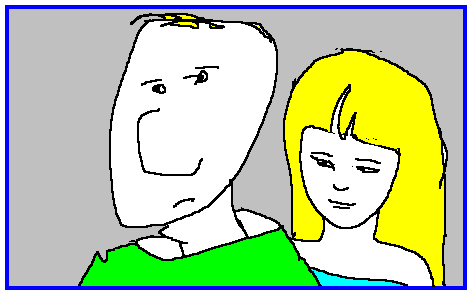 となると、ルミコちゃん、あんた、趣味は?
となると、ルミコちゃん、あんた、趣味は?
「歌、かな」
歌うの?
「うん」
<うたってよー>
「うん、また今度ね、でもね、好きなのはね、Amazing Graceだよ」
「へえ、なんだい、そのアメエジングってえのは」
「あとで歌ってやるよ」
はいはい
じゃ、次は、ゴーファー
[おいらかい? てれくさいな、ま、いいや]
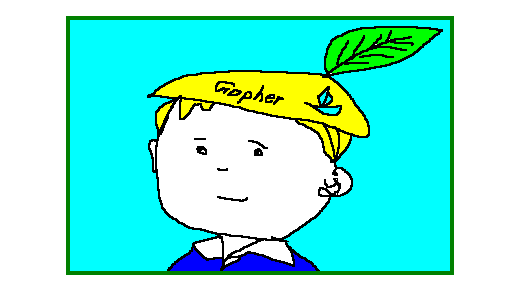 好きな食べ物は?
好きな食べ物は?
[えーと、アイスクリーム]
どんなの?
[こう、あまくってさ、おっかさんのにおいがしてさ、]
へえ、おっかさんがいるの?
[いたんだ...]
そうか、やさしかったんだ
[うん]
[いつもさ、おっかさんとかくれんぼしてさ、]
[アイスクリームつくるの、すごく上手なんだ]
「ゴーファー、あとで作ってやるよ」
[ありがと、ねえちゃん]
次は、バショウネさん
「いや、ユードラを先にやってくれんかな、この子はいい子だ」
じゃ、ユードラ、おいで
「はい」
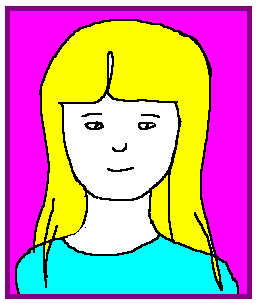 何がすきかな?
何がすきかな?
「はい、風のにおいとか、花の香りとか、太陽のひざしとか、そんなのが好きです」
ふーん、ユードラにぴったりだな
いつもどこにいるの?
「空の中のバケットにいます」
?
「ほら、tonyさんの言ってらっしゃるbucket in the skyです。」
はあーん、the message must have gone to the great bit bucket in the sky
この間、メールが行方不明になったとき、そんなこと言ってたっけ、そおう、bucketにいるの?へえー
<ふーん>
「はい、次はネッツィーだよ」
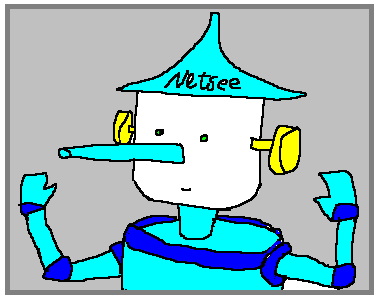 [ハイデス]
[ハイデス]
ふむ、ネッツィーは、万能なんだよな、特技は?
[エー、サガシモノ、デス]
うむ、さすがに、ふむ
ウィザーダヴァズ、なんだよな
[ハイ、ゾンジテマスデス、wizard of OsノTin manデス]
あたり、そのイメージなんだ、ぼくはボームのファンなもんだから
このごろ、お世話になってます
[ドーモドーモ]
さてと、
「おくにさん、おいで、さ、あんたとわしの番だ」
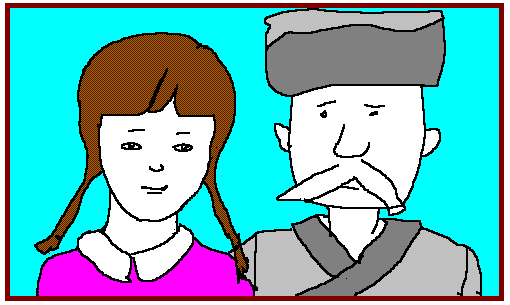 「まず、わしは、ま、古い人間だな、がんこだしな、質問は勘弁勘弁」
「まず、わしは、ま、古い人間だな、がんこだしな、質問は勘弁勘弁」
「わたしも、勘弁勘弁」
ま、いいか
「春日野の とふひの野守り いでてみよ いまいくかありて 若菜つみてん、といくか、な、エム」
「なんか、わかんないんだけど、」
おれもわからんな、バショウネさんの心境は
ほう、日がさしてきた。ユードラのすきな太陽の日差しだ。
日差しだ、ひざしだひざしだ......
ん?みんな、どこ行った?
------------------------------------------------------------------------
「ねえ、みんな、どっか、行きましょうよ」
「おっ、おくにちゃん、元気出てきたじゃねえか、よっし、行こうか」
「で、どこに行く?」
<えーとねー、えーとねー>
[そうだなあ、どこがいいかなあ]
「やっぱり、おくにちゃん、あんたが決めなきゃな」
「はい、えーとー、」
「ふんふん」
「こら、せかしちゃだめでしょ」
「はいはい」
「エートー、フィレンツェ、」
「ほう、フィレンツェ、えー、そりゃなにかなあ」
「あんたばかねえ、イタリアの有名な町じゃない」
「そりゃ、おれはバカだがね、フン」
「ごめん、言葉のあやだから、チュッ」
「ま、いいや」
[ネッツィー、たのむよ]
[ハイデス]
[クニコサン、NetscapeのNet Searchクリック]
クリック
「Internet Searchね」
[Search Enginesでfirenze、ってタイプして、Searchをクリック]
firenzeクリック
「あ、出た」
You searched for: firenze
Titles: 1 through 10 of 100
「100件中10件、とりあえず表示、ということかしら」
FIRENZE−FLORENCE
「Firenzeって、Florenceともいうのかしら、イタリア語で解説してる
「ちょっと反応が遅いから、OptionsでAuto Load Imagesをオフにしましょ」
FIRENZE-FRORENCEクリック
Contacting host:www.dada.it
FIRENZEinfo
「あらー、全部イタリア語」
BACKクリック
「次、Home page della Firenze On Lineクリック」
Benvenuti nel WWW della Firenze On Line - Societ
「あ、Available also in English、これ、やってみよう」
クリック
「反応、なし、じゃ、元に戻って、
「今度は、Firenze Yellow Page
クリック
FIONLINE YELLOW PAGES
Un insieme di indirizzi utili divisi per.....
LYCOS
YAHOO
WEB CRAWLER
WWW SERVER
ITALIAN GENERAL SUBJECT TREE
STARTING POINT
MASTER LIST
CITY NET
「このCity Netってなにかしら
クリック
CITY NET
October 29,1995: 1126 cities and 557 other destinations online!
「これこれ」
Italyクリック
Ascoli Piceno
Bari
bologna
Bresca
....
Florence
クリック
Florence WWWクリック
Sorry, these WWW pages have another address
another addressクリック
This is a service of T.C.A.srl,Florence
[IMAGE]
「あ、これじゃない? 出た出たー
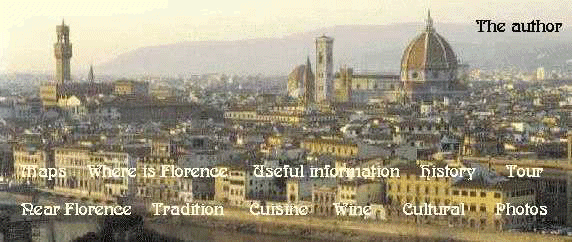 「ロケーションは、http:/www.inib.it/staff/max/florence.ht、ね」
「ロケーションは、http:/www.inib.it/staff/max/florence.ht、ね」
「おっ、やったね、おくにちゃん、てえしたもんだ」
「すてきな町じゃない」
[おいらの生まれ故郷に似てるかなあ]
<おいらもー、そーかなー>
「ふむ、結構ですな」
「時間があったら、ゆっくり行きたいな」
「えーと、次は、と」
Tour in Florenceクリック
http://www.inib.it/staff/max/tour.ht
Now you can visit some places and monuments in Florence. You can find descriptions about all the places in the list below. Only a few part of the places have got photos at present.
Piazza Duomo
Piazza Signoria
Piazza Signolia
Uffizi
Piazza Santa Croce
Ponte Vecchio
Piazza Pitti
Piazza Michelangeloクリック
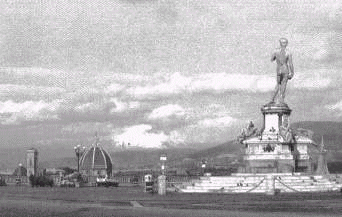 「わあー、あれ、ダビデじゃない? あんなに大きいんだ
「わあー、あれ、ダビデじゃない? あんなに大きいんだ
「フィレンツェ、じゃないか、フローレンスの歴史ってどんなかなあ」
Florence must be considered a city of Roman origin. It was founded with the name Florentia in the spring of 59 B.C., near the Arno river and only six kilometers from the already thriving Fiesole. The availability of flat lands and the nearness of a river that was navigable to the sea were the basis for the development of the new settlement which soon began to complete with Etruscan Fiesole.
最初は、ローマ人の町だった。紀元前59年にFlorentiaという名前だった。アルノ川のそばで、Fiesoleっていう栄えていた町から6キロしか離れていなかった。平地だったし、海に通ずる川の近くだということで、繁栄していった。
It was mainly starting from the XI century that the economy and political recovery of Florence began. In these years Florence supported the reforms of Pope Gregory VI against the interference of the Emperor Henry IV and became a political center of not insignificant import, thenks mainly to the Countess Matilde di Canossa who governed the Tuscan region.
11世紀から経済や政治がしっかりしてきて、ローマ法王Gregory6世が皇帝ヘンリー4世に抵抗するのを支援したりして、政治の中心になってきた。
After centuries of barbarian invasions the boundaries themselves were
increased with the fifth circle of walls built from 1173 to 1175. During
this period the physiognomy of the Comune began to take shape, first through a
consular government and then with the creation of a podestral regime.
何世紀にもわたる異民族の侵攻のため、1173年から1175年にかけて、外壁を造った。
The city was divided by the internal conflicts of the richest families who were vying for political as well as economic power. The conflict became evermore violent and bitter until two factions were formed: the Guelfs who were faithful to the Papacy, and the Ghibellines who supported the Emperor.
経済と政治を牛耳っていた富裕な一族の内紛のために、町は分割された。やがて、法王側のGuelfs家と皇帝側のGhibellines家の二つの勢力に集約された。
Finally, in 1268 the Guelfs came to power definitively and Florence was now a rich and powerful city.
1268年、Guelfs家が実権を握り、Florenceは富裕かつ権力のある都市になった。
In 1258 the left bank of the Arno was encircled by the walls. The population grew considerably: towerhouses became numerous within the city while the hamlets stretched to the city gates. The great churches of Santa Maria del Fiore, Santa Croce and Santa Maria Novella were built. The first two were the work of Arnolfo di Cambio, the great architect and sculptor.
1258年にアルノ川の左堤防は外壁で囲まれた。人口は増え続け高層建築が多くなってきた。Santa Maria del Fioreなどの有名な教会が造られた。
「うーん、あとはそのうち、翻訳しましょ」
The new prosperity favored the development of the visual arts: thanks to Cimabue paintings found new roads of expression, while Arnolfo and Andrea Pisano were considered the founders of Florentine sculpture. This flowering of artistic talenton the threshold of the fourteenth century reached his peak with Giotto whose paintings were of incalculable importance. The Divine Comedy by Dante Alighieri is the definitive work which consacrated a vernacular tongue that attained literaty dignity.
The fourteenth was not an easy century for Florence: battles continued with other Tuscany cities and the wool carders revolted ( the Revolt of the Ciompi ) demanding political recognition in the city government.
At the beginning of the XV century in the midst of the crisis of the democratic institutions the economic power of the rich banking families increased. The time was ripe for drastical political change and it occured in 1434 when Cosimo De' medici siezed power.
Cosimo conducted a policy of careful alliancesand great increases in commerce which led the city to unprecedent prosperity. His method of government was carried on and improved by his nephew Lorenzo, a refined
patron of arts and letters who camo to be known as the Magnificent. A true court of philosophers, poets and artists gathered around Lorenzo.
Starting with the times of Cosimo a new civilization, based on a profoundly different concept of man and his existence on earth was born and developed.
The Humanism was expressed in a different type of artistic sensitivity, a strong scientific impulse and a rediscovered dialogue with the classical world.
Brunelleschi, in architecture and Masaccio in painting directed their efforts to the creation of perspective while Donatello reviver sculpture. In his statues, as Masaccio's paintings, the human form took on a meaning and ignity that were previously unknown. In the path of these three key figures a multitude of eccellent artists worked in Florence and created many fifteenth century masterpieces.
At the end of 15th century and during the 16th century the Medici dominion was threatened by those who wanted to restore the ancient republican ideals.
Among these was Savonarola, the fiery Dominican monk whose sermons were based on the lost values of liberty and morality. But the republican adventure was short-lived. Savonarola was burned in 1498.
While Machiavelli was expounding the cold ethics of the modern state, Cosimo I, gave the Tuscan state its solid foundations, levelling the social components and concentrating his power. He subdued Siena (1555), extending his dominios to include all of the Tuscany and the seas. He was the Geand Duke of Tuscany. The policy of concentralization of the Medicean Grand Duchy also influenced culture. The court artists came into existenc such as Vasari while the geniuses of the era (Leonardo, Michelangelo, Raphael) had difficulties with the trying relationship between art and power and chose new goals (Milan and Rome).
The Medici dinasty, however, have merits which included the encouragement of scientific research, thanks mainly to the existence of personalities such as Galileo Galilei and Torricelli.
Three century of Medici ruleended in 1737 and Florence began a long period of cultural decline.
Florence and Tuscany welcomed Napoleon's reforms (1801)and so the region was annexed to the French empire until his fall.
At the close of the Napoleonic era the city came under Lorrain domination until 1859. In the cultural realm the eighteenth century was followed by a phase characterized by the romantic rediscovery of the Middle Ages.
From 1865 to 1870 the city of Florence was the capital of the Kingdom of Italy; this led to a drastic process of rebuilding of the city which also included the destruction of the medioeval city walls.
In the 19th century the city enjoyed an intense artistic-literaty season which was fueled by the publication of many journals. The greatest names of the period contributed to these reviews until Fascist censorship put an and intellectual expression.
During World War II, as the front moved from the Arno river to the Gothic line north of the city, Florence was severely tried and had to endure widescale destruction of the historical center. The city played an active part in the Resistance and then dedicated itself passionately to recostruction.
In the same way, after the shock of the flood which occurred on November 4, 1966, with uncommon will-power and strength, and generous contributions from all over the world, Florence recovered from disaster.
「ということで、いまは、外壁はない、というわけ、なるほど
「ちょっと、つかれちゃった
「ね、みんな、あら?どこ行ったの?
「ウェブさん?ん?ゴーファーさーん、シャラクネさーん、バショウネさーーん、
おーい、くにこー、くにこー、こっちだ、こっちだ、何してるんだ、間に合わないぞー
「えー? なーにー? どうしたのかしら、いまの、あれ? おとうさん?
おねえちゃーん、早く早く
「え?なにこれ、あら、船
「わたしって、どうしていつも こんなにせかされるのかしら
急げ、いそげー
早く、はやくー
よーーし、間にあったあ
「ああ、しんど
「あれ、おとうさん? どこ? いないの? みんな、どこ?
おーい、おーーい、おくにちゃーーん、元気でなあー
「あらいやだ、シャラクネさーーん、ああ、船が動いてる、みんなー、もう、あえないのー?
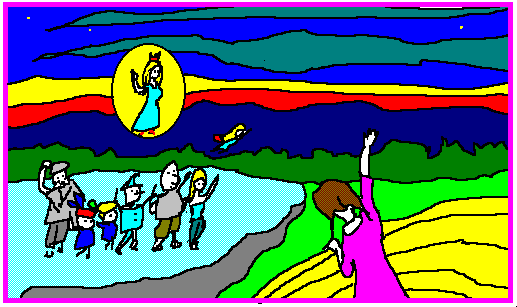 元気でなあー、
元気でなあー、
<また、きてねー>
まってるよー
「うーーん、うーん、うん、....さよなら、さよならーー、たのしかった、たのしかったーー
「くにこ、くにこ、ほら、風邪引くぞ」
「え?ここどこ?」
「風邪ひいてしまうじゃないか、早く風呂に入りなさい」
「え?今日は何日?」
「なにアホなこといってんだ、さっき帰ってきたばかりじゃないか」
(エフム、お父さん、わたし、ハネムーンは、フローレンスに決めた)